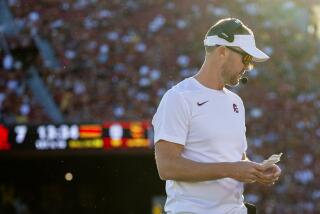Boosting The Goal Patrols : Sockers: Opponents firing blanks--and sometimes not firing at all--during recent streak.
- Share via
SAN DIEGO — The Sockers have always been good for an explanation.
Not anymore. They’ve become stingy, and in more ways than one.
After allowing 63 goals and compiling a 3-7 record in their first 10 games, the Sockers have allowed 49 goals and have gone 7-3 in the past 10 games.
Take away Friday’s 11-6 loss to Cleveland, and opponents have been scoring an average of 4.11 goals per game since the Sockers turned things around. This in a league with games that average more than 11 goals per game.
But the Sockers also have become adept at deflecting questions about their stepped up patrols in front of the goal.
What’s happening back there?
Sockers players would have you believe fate has something to do with their recent success.
It’s sort of like that bumper sticker.
Defense happens.
And why not? If Dan Quayle can happen, surely a group of unknown soccer players, even two who never played indoor, can bumble along and--oops!--one day preside in front of Major Soccer League goal boxes.
The Sockers have won four in a row at home and seven of 10. Much of the credit is going to the guys who started the season as built-in excuses as to why the team wouldn’t gain a ninth indoor title.
The would-be defensive scapegoats include: David Banks, a rookie who had never before played the game; Alex Golovnia, a Soviet import who also had never before played indoors; Glen Carbonara, a castoff from the Baltimore Blast; Ben Collins, previously a midfielder who spent most of last year on injured reserve; and Jim Gabarra, who before this year spent his career largely unnoticed in the midfield.
It looked as if Coach Ron Newman was going to pull a Paul Westhead this season and just forgo defense.
But as it turned out, these guys look nothing like the Denver Nuggets. Quite the opposite, in fact.
In the team’s last two home games, the defense put opponents in the record books near the top of the all-time list for fewest shots in a half.
First, Cleveland managed only three shots in the first half of an eventual 10-3 Sockers victory. Two days later, Dallas under-did Cleveland. It aimed only two shots on goal during the opening half and eventually fell, 5-4, in overtime.
There’s more: Dallas took only five shots in the second half to finish with seven after four quarters--the fewest attempted by an MSL team in regulation.
The kicker: The Sidekicks could not get off a shot during a power-play in overtime. Two minutes later, they lost.
And remember, the Sockers are a team minus three defensive standouts off last year’s squad.
Gone are George Fernandez, who led the team with 98 blocked shots a year ago; Ralph Black; who finished No. 3 on the team with 57 blocks; and Cacho, whose 41 blocks were fourth-highest.
“Everyone was asking, ‘How can you let George Fernandez go? How can you let Ralph Black go? How can you not sign Cacho,’ ” remembered Erich Geyer, assistant coach. “Well, what’s George Fernandez doing now?”
Fernandez, who signed as a free-agent with the Cleveland Crunch, is nowhere near the pace at which he blocked 98 shots last year. After 19 games, Fernandez has 24 blocks.
No one has filled the void created by Fernandez’s departure in the Sockers blocked-shots column. After Kevin Crow’s 38, the next highest total is 11.
So the initial inclination is to credit goalie Victor Nogueira for the team’s success. Since the Sockers have no proven back-up, Nogueira is the only goalie in the league to have started all of his team’s games (20). Yet, he is second in the MSL in goals-against average at 5.14 (5.03 before the Cleveland debacle).
There is an irony there considering a goalie’s GAA tends to rise as does his minutes played.
But Nogueira appears to be growing stronger, not weary, without a platoon partner.
“I’ve been very pleased, No. 1 with his performance, and, No. 2 with his consistency,” Coach Ron Newman said. “He doesn’t seem to be suffering from playing too many games.”
Nogueira, in fact, thinks that all the starts are actually a benefit at this point in the season.
“I play better when I get a lot of playing time,” he said. “It allows me to get into a rhythm. But I would be stronger at the end of the year if we did rotate.”
His goals-against average seems to be proof that Nogueira has found a comfortable niche. It’s down from 5.83 10 games ago.
Nogueira, however, deflects credit to his defenders.
“I’m not doing that bad,” Nogueira conceded, “but our defense is doing very well.”
It’s doing well, Nogueira said, because, “everyone’s doing what Kevin (Crow) is doing. He stands in front of the forwards instead of behind them.”
It’s the nature of the game, Crow said. Indoor soccer simply allows for a defender to go for the interception. In outdoor soccer, on the other hand, defenders must guard against getting beat.
“I didn’t even know Kevin did that until I saw him demonstrating,” Nogueira added.
The demonstration came, fittingly enough, 10 games ago when the Sockers began their march to .500.
Bring this to Crow’s attention, and he makes like Nogueira and passes the buck. “Most of the credit has to go to the front players,” he said. “The forwards and midfielders are pressuring so well that the other teams aren’t even getting the ball up field.”
Newman agrees.
“It’s not just the defenders,” the coach said. “It’s the whole team working as a unit when the team’s on defense.
“We don’t start looking like a championship team until everybody starts coming back on defense. It takes a whole team to stifle any production (an opponent) can put together.”
Still, Newman acknowledges there is another explanation, and that is the progress of both the new players--Banks and Golovnia--and that of the former midfielders--Collins and Gabarra.
Banks has emerged as one of the league’s most physical players; Golovnia, who in his 10 years of outdoor soccer in the Soviet first and second divisions never crossed the midfield stripe, has become comfortable enough to go forward and get involved with the offense; Gabarra and Collins have become total field players and are among team leaders in points and blocks.
What’s odd about all this is that each player seemed to hit his stride simultaneously.
That, Newman and Geyer say, is a product of confidence.
“Enormous amounts of confidence,” Newman said. “I’m a great believer in confidence. A team that plays with confidence is much better than one that doesn’t.”
Geyer has a theory about Sockers’ winning attitude.
“I think it has to do with where we play,” he said. “The whole set-up of Southern California is a little cocky.
“Some people say we’re arrogant, but I don’t think so. We’re confident, and our players really work hard for their success. But on the other side of the coin, they have fun at the same time.”
More to Read
Go beyond the scoreboard
Get the latest on L.A.'s teams in the daily Sports Report newsletter.
You may occasionally receive promotional content from the Los Angeles Times.










